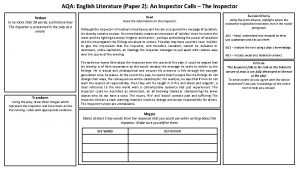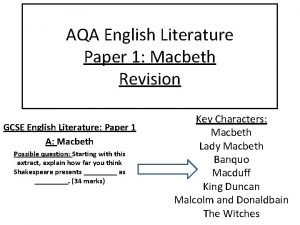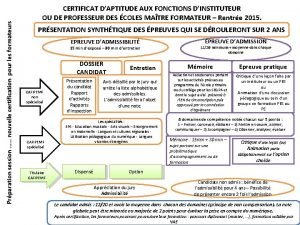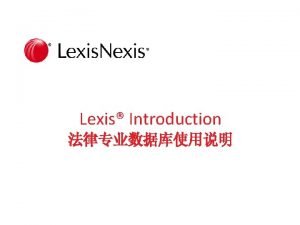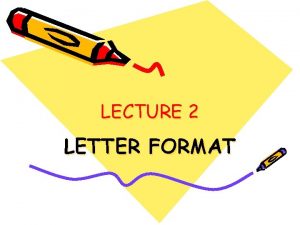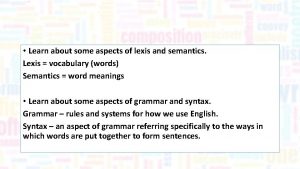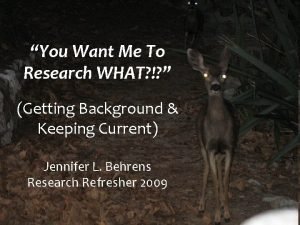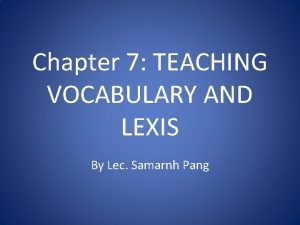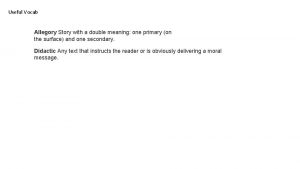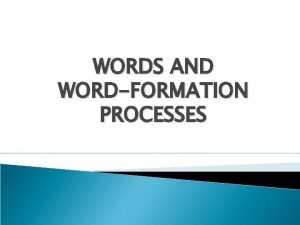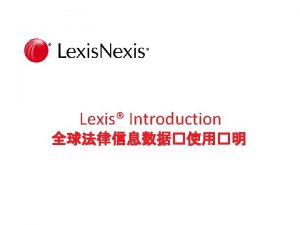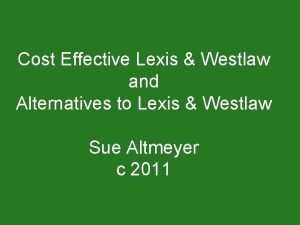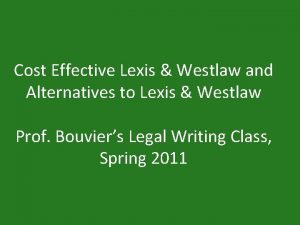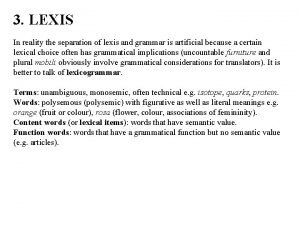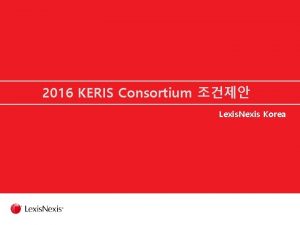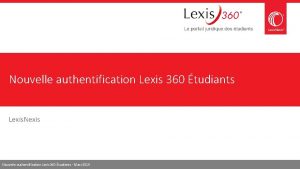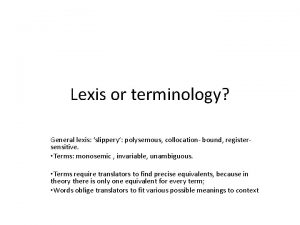Lexis 1 Wordformation processes English calls upon a




















- Slides: 20

Lexis 1

Word-formation processes English calls upon a number of devices as a means of forming new words on the bases of the old. A form to which a rule of wordformation is applied a BASE (as distinct from STEM), and the chief processes of English wordformation by which the base may be modified are: 2

AFFIXATION (a) Adding a prefix to the base, with or without a change of word-class (eg: author ---- co-author). (b) Adding a suffix to the base, with or without a change of word-class (eg: drive ---- driver). 3

Conversion is the derivational process whereby an item is adapted or converted to a new word-class without the addition of an affix. In other words, assigning the base to a different word-class without changing its form (“zero affixation”, e. g. : drive (v)--- drive (n). 4

Compounds A compound is a unit consisting of two or more bases. In other words, by adding one base to another. Such compound words can be nouns (eg: blood+test= blood test, adjectives (eg: tax+free= tax-free), or verbs( eg: spring+clean=spring-clean) 5

Cont. Orthographically, Compounds are written (a) solid , eg: bedroom (b) hyphenated, eg : tax-free (c) open, eg: reading material 6

Clipping The term clipping denotes the subtraction of one or more syllables from a word, which is also available in its full form. The clipped form is normally felt informal. 7

Clipping The shortening may occur at (a) The beginning of the word: Phone telephone Plane airplane, aeroplane Bus omnibus 8

Cont. end of the word (more commonly): ad advert(isment) photograph examination 9

Cont. h ends of the word (not a common type of clipping): Flu influenza Fridge refrigerator (esp. Br. E) 10

BLENDS In a blend at least one of the elements is fragmentary when compared with its corresponding uncompounded word form. 11

For example Smog smoke+ fog Interpol international police Motel motor hotel Newcast news broadcast Brunch breakfast+ lunch 12

ACRONYMS Acronyms are words formed from the initial letters( or larger parts) of words that make up a descriptive phrase or a proper name. New acronyms are freely produced in Modern English, particularly for names of organizations. There are two main types: 13

Cont. (1) Acronyms which are pronounced as sequences of letters can be called “alphabetisms”. (a) The letters represent full words: C. O. D. Cash on delivery FBI Federal Bureau of Investigation UN the United Nations 14

Cont. (b) The letters represent elements in a compound or just parts of a word: TV television GHQ General Headquarters ID identification card TB tuberculosis 15

Cont. (2) Acronyms which are pronounced as word, and are often used with out knowing what the letters stand for: NATO the North Treaty Organization ed Nations Educational, Scientific and Cultural Organization 16

Backformation Typically, a word of one type (usually a noun ) is reduced to form another word of one type (usually a verb). A good example of backformation is the process in whereby the noun television first came into use and the verb televise was created from it. Examples: edit (from ‘editor’) donate (from ‘donation’) emote (from ’emotion’) 17

Borrowing One of the most common sources of new words in English is the process simply labeled borrowing, that is, the taking over of words from other languages. 18

Cont. The English Language had adopted a vast number of loan-words from other languages, including alcohol (Arabic), boss (Dutch), croissant (French), lilac (Persian), piano (Italian) and yogurt (Turkish). Other languages borrow terms from English, as can be observed in the Japanese use of suupaamaaketto (supermarket). 19

Coinage The invention of totally new terms. Our fanciful creation of somp would be one example. Words like aspirin and nylon, originally invented trade names, are others. 20
 Concurrent in os
Concurrent in os Aqa english literature paper 1 an inspector calls
Aqa english literature paper 1 an inspector calls Macbeth revision
Macbeth revision Stylistic synonyms lexicology
Stylistic synonyms lexicology Certification lexis 360
Certification lexis 360 Lexis power invoice
Lexis power invoice Lexis diligence review
Lexis diligence review Discourse community definition
Discourse community definition Lexis of
Lexis of Attention line in address
Attention line in address Lexis and semantics meaning
Lexis and semantics meaning Accder
Accder 以圖找文
以圖找文 Lexis advance reviews
Lexis advance reviews Eutracker
Eutracker Lexis infopro
Lexis infopro How much does lexis advance cost
How much does lexis advance cost Lexis 360 étudiant
Lexis 360 étudiant Etl vs middleware
Etl vs middleware Difference between vocabulary and lexis
Difference between vocabulary and lexis Double meaning story
Double meaning story

